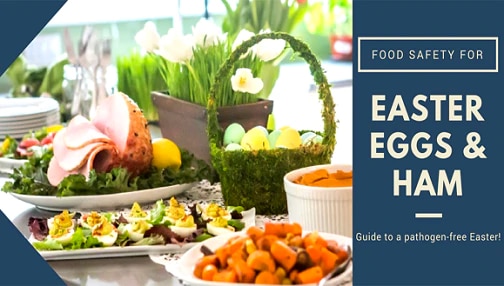
If you’re reading this blog, chances are, you enjoy eating ham. After a day of hunting for eggs and chasing the kids around the yard on Easter, it’s time for the family to enjoy that delicious ham they have been waiting for.
Things to know about proper ham preparation
Whether you are cooking a raw ham or preparing a ready-to eat ham product, follow these steps for a ham that is cooked to perfection.
- Ham that is not ready-to-eat but has the appearance of ready-to-eat products will bear a statement on the label indicating the product needs cooking.
- Ham that requires cooking before consumption or fresh, raw ham must reach an internal temperature of 145°F (63°C) (with a three-minute rest time). Set the oven no lower than 325°F (163°C).
- Cooked canned ham and cooked vacuum-packaged ham, both from federally inspected plants, can be eaten right out of the package. All of these along with spiral-cut cooked ham are safe to eat cold or can be warmed to an internal temperature of 145°F (63°C), as they are already fully cooked. For cooked hams that have been repackaged in any other location outside the processing plant, heat to an internal temperature of 165°F (74°C), measured with a food thermometer, before you serve it.
For more background information on the kinds, storage and cooking times for ham, visit Ham and Food Safety.
Egg Safety
Did you know that Salmonella bacteria can be found on both the outside and inside of eggs that appear to be normal? The larger the number of Salmonella present in the egg, the more likely the egg is to cause illness.
To enjoy eggs without the risk of getting sick:
- Store eggs in the refrigerator.
- Discard any cracked or dirty eggs.
- Be sure to wash hands and any surfaces (counter tops, utensils or dishes) after contact with raw eggs.
- Cook eggs thoroughly until both the yolk and white are firm. Cooking reduces the number of bacteria in an egg. Lightly cooked egg whites and yolks have both caused outbreaks of Salmonella infections.
- Recipes containing eggs mixed with other foods should be cooked to an internal temperature of 160°F (71°C).
- Eat eggs promptly. Don’t keep them warm or at room temperature for more than two hours. DO NOT EAT hard-boiled eggs used for an egg hunt or as decorations if they have been at temperatures above 40°F (4°C) for more than two hours; discard them.
Consumers with questions about food safety can call the USDA Meat and Poultry Hotline at 1-888-MPHotline (1-888-674-6854) or chat live with a food safety specialist at Ask USDA , available from 10 a.m. to 6 p.m. Eastern Time, Monday through Friday, in English or Spanish.

